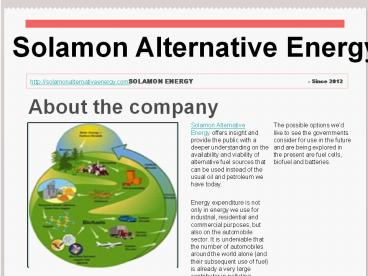Solamon Alternative Energy - PowerPoint PPT Presentation
Title:
Solamon Alternative Energy
Description:
Solamon Alternative Energy offers insight and provide the public with a deeper understanding on the availability and viability of alternative fuel sources that can be used instead of the usual oil and petroleum we have today. Energy expenditure is not only in energy we use for industrial, residential and commercial purposes, but also on the automobile sector. It is undeniable that the number of automobiles around the world alone (and their subsequent use of fuel) is already a very large contributor in polluting nature. The possible options we’d like to see the governments consider for use in the future and are being explored in the present are fuel cells, biofuel and batteries. – PowerPoint PPT presentation
Number of Views:101
Title: Solamon Alternative Energy
1
Solamon Alternative Energy
SOLAMON ENERGY
http//solamonalternativeenergy.com/
- Since 2012
About the company
Solamon Alternative Energy offers insight and
provide the public with a deeper understanding on
the availability and viability of alternative
fuel sources that can be used instead of the
usual oil and petroleum we have today. Energy
expenditure is not only in energy we use for
industrial, residential and commercial purposes,
but also on the automobile sector. It is
undeniable that the number of automobiles around
the world alone (and their subsequent use of
fuel) is already a very large contributor in
polluting nature.
The possible options wed like to see the
governments consider for use in the future and
are being explored in the present are fuel cells,
biofuel and batteries.
2
Auto Industry Sees Big Potential For Fuel Cells
NEWS
Date today 08/15/12
The News Suzuki and Intelligent Energy have
teamed up to create SMILE FC System Corp that
will develop air-cooled fuel cell
systems.According from the announcement, their
joint venture also consists of a non-exclusive
license agreement that will give Suzuki the
access to IEs fuel cell technology to be
employed on their vehicles. On the other hand, IE
stands to benefit from the production expertise
of Suzuki and the Japanese supply chain.
Its indeed a huge step towards the
commercialization of auto fuel-cell systems. In
fact, IEs air-cooled fuel cell system is in the
Burgman scooter that became the worlds first
such vehicle to get the European Unions WVTA
(Whole Vehicle Type Approval) in 2011. Strong
interest in fuel cell cars from the industrial
sector and government departments in Korea, China
and Japan have seen a promising growth. vim.
- Next
For instance, General Motors has already allotted
USD 2 billion in RD and is slated to introduce
fuel cell cars in Europe and America on
2016. According to a prominent oil firm, fuel
cell vehicles can possibly make up 40 of the
global auto market by 2051. Automakers on their
part, are saying that vehicles that run on
natural gas might end up as only 5 of the total
global number by 2040.
Carmakers are recently starting to invest heavily
on fuel cells with several of them already
launching models.
3
Use Of Biofuel In The Military Faces Tough
Opposition
Barack Obamas administration has backed the use
of biofuels in powering its military, seeing it
as a chance to immune itself from sharp fuel
price fluctuations, especially after the Navys
successful test of the technology.
But despite their efforts, the US Congress could
stop the Defense Department from investing in
alternative fuel until the price has become
competitive to conventional sources.
The Navy has made its first attempts in going
green in 2009 and made tests on the jet engines
on the biofuel mix in 2010. However, the project
was questioned in 2011 when the Navy reportedly
spent USD 450,000 on biofuels (composed of
chicken fat and algae), costing around USD 15 per
gallon, which is quite expensive compared to the
USD 3.60 for the usual fuel.
The plan was met with strong criticism for its
being very costly. Moreover, the Department of
Defense was reportedly obliged to implement
budget cuts by reducing the number of its
personnel, aircraft, ships and important military
programs.
4
McCain insists the program is simply too
expensive, saying I was just reading, its the
cost of one destroyer 1.8bn extra they want
to spend on this green technology. The fact is, I
just do not believe that we need to spend that
kind of money on it.
Absolutely it was worthwhile to show that
biofuels can compete and can be used in every
single thing that we do in the navy. This shows
that its operational. Everything before now has
been a test. This shows we can use biofuels and
other alternative energies in an operational
manner, said Navy Secretary Ray Mabus.
Mabus is trying to reassure Republicans that
there will be no big purchases of such biofuel
until the time it becomes cost-competitive with
conventional aviation fuel.
5
Mabus also said that the test exercise will prove
for the first time that aircraft carriers and
jets can run with advanced biofuel as
their energy sources.
As they said, they only have to find a way to get
local-made fuel which has a stable price and
could be competitive with the usual oil.
For the carrier strike test, the Navy bought
450,000 gallons of alternative fuels amounting to
USD 12 million (USD 27 a gallon) but because they
were mixed with the conventional petroleum in a
50-50 blend, the final cost is roughly USD 15 a
gallon. A strike force of 71 jet fighters,
transport planes and helicopters set off on a
demonstration flight off Hawaii this week using
the biofuel mix.
Mabus added, It was worthwhile to show that
biofuels can compete and can be used in every
single thing that we do in the Navy. Everything
before now has been a test. This shows that we
can use biofuels and other alternative energies
in an operational manner.































